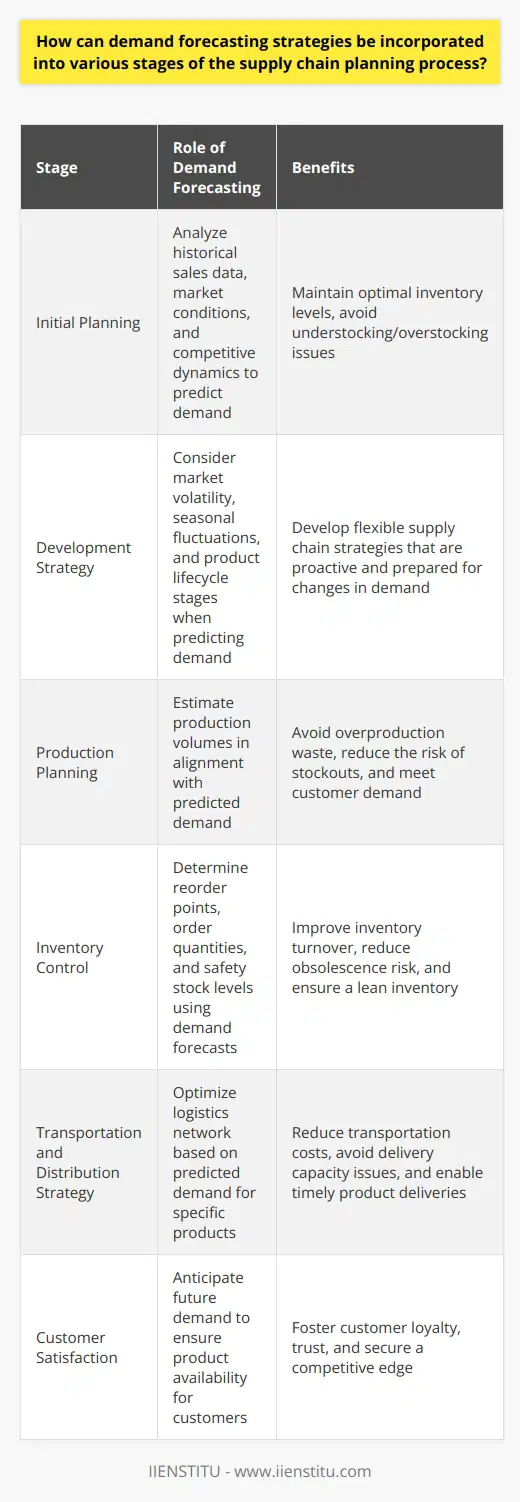
I remember the first time I walked into the warehouse of my family's small business. The towering shelves, the buzz of forklifts, and the endless rows of products were both exciting and overwhelming. My father, who had been managing the supply chain for decades, turned to me and said, "Understanding demand is like reading the pulse of our business."
Estimating demand isn't just about numbers; it's about anticipating the needs of our customers and ensuring we're prepared to meet them. Over the years, I've learned that demand forecasting is an art as much as it is a science.
Introduction
Estimating Your Demand
Understanding Your Needs
Demand Forecasting
Difficulty of Estimating
Understanding Your Needs
At its core, demand forecasting is about predicting how much of an item you'll need in the future. This isn't always straightforward. Factors like seasonal trends, market shifts, and even customer purchasing behaviors can throw off our estimates. But without this foresight, we're navigating the supply chain blindfolded.
The Importance of Demand Forecasting
Let's imagine you're running a boutique coffee shop. One week, you're selling 50 cups of coffee a day. Suddenly, a new office building opens nearby, and without warning, you're facing long lines and running out of stock by midday. Not having enough supplies can lead to lost sales and unhappy customers. On the flip side, ordering too much can tie up your cash in inventory that sits on the shelves.
Demand forecasting helps businesses optimize their supply chain management process tips. By making educated guesses about future demand, we can adjust our purchasing, production, and staffing accordingly.
The Challenges of Estimating Demand
I won't lie; estimating demand can be tricky. There was a time when we overestimated the popularity of a new product line. We ended up with a warehouse full of unsold items. That experience taught me invaluable lessons about the difficulty of estimating demand accurately.
Some of the challenges include:
Market Volatility: Sudden changes in the market can render forecasts obsolete.
Consumer Behavior: Customers can be unpredictable. Trends come and go.
Supplier Issues: Delays or problems on the supplier's end can affect inventory levels.
Global Events: Economic shifts, pandemics, and geopolitical events can impact demand.
Data Limitations: Inaccurate or incomplete data can lead to flawed forecasts.
Estimating Your Demand: How to Make Smart Decisions
Analyzing Customer Purchasing Behavior
One of the first steps in demand forecasting is understanding your customers. Are there certain times of the year when sales spike? Do promotions influence buying habits? By analyzing past sales data, we can identify patterns.
For example:
1- Seasonal Trends: Ice cream sales soar in the summer.
2- Holidays: Retailers see increased demand during festive seasons.
3- Economic Indicators: A booming economy might increase luxury item sales.
4- Local Events: Concerts or festivals can drive up short-term demand.
An accurate estimate of demand is the foundation of successful supply chain management.
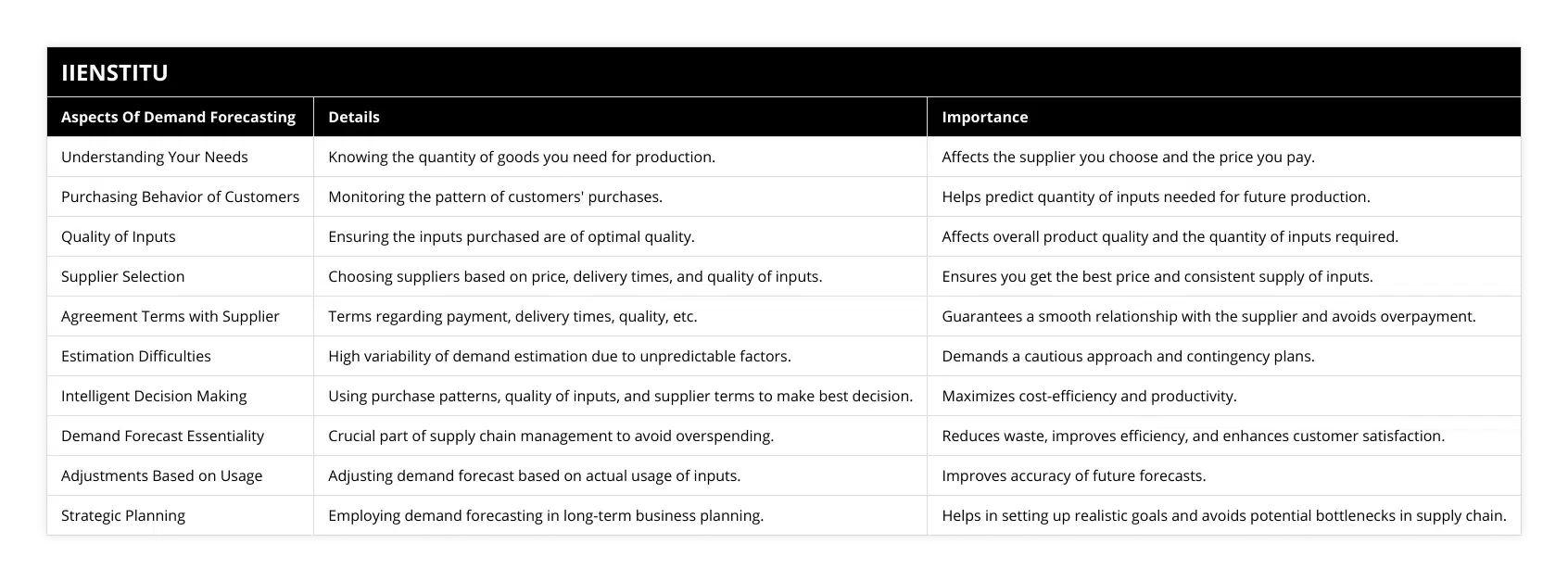
5- Competitive Actions: A competitor's sale can impact your sales.
Choosing the Right Suppliers
Selecting suitable suppliers is crucial. Not all suppliers are created equal. When evaluating suppliers, consider:
Quality of Inputs: Higher quality might cost more upfront but can lead to better customer satisfaction.
Pricing: Negotiating favorable terms can improve profit margins.
Reliability: A reliable supplier ensures timely delivery, preventing stockouts.
Flexibility: Can the supplier adapt to changes in your demand?
Location: Local suppliers might offer faster delivery times.
Negotiating Terms with Suppliers
Building strong relationships with suppliers pays off. When negotiating:
Payment Terms: Can you secure net-60 instead of net-30?
Bulk Discounts: Is there a price break for larger orders?
Delivery Schedules: How flexible are they with delivery times?
Return Policies: What are the terms if products don't sell?
Exclusive Agreements: Can you secure exclusivity to gain a competitive edge?
I recall working with a supplier who agreed to a consignment stock arrangement. It allowed us to hold stock without immediate payment, improving our cash flow.
Tools and Techniques for Demand Forecasting
Several methods can aid in demand forecasting:
Historical Sales Analysis: Reviewing past sales data.
Market Research: Understanding industry trends.
Statistical Models: Using algorithms and software to predict demand.
Collaboration with Sales Teams: Gaining insights from those on the front lines.
Leveraging SCM Supply Tools: Utilizing specialized software designed for supply chain mgmt to forecast demand accurately.
Statistical Models
Statistical models can range from simple moving averages to complex machine learning algorithms. They help in:
Identifying Trends: Recognizing upward or downward sales trends.
Seasonality Adjustments: Accounting for seasonal fluctuations.
Predictive Analysis: Forecasting future demand based on multiple variables.
Technology in Demand Forecasting
Embracing technology can enhance accuracy:
Inventory Management Systems: Track stock levels in real-time.
Customer Relationship Management (CRM): Analyze customer interactions.
Big Data Analytics: Process large datasets for deeper insights.
Artificial Intelligence (AI): Predict patterns humans might miss.
The Role of Supply Chain Management in Demand Forecasting
Supply chain management (SCM) is all about overseeing the flow of goods from suppliers to customers. Effective SCM management relies heavily on accurate demand forecasting. It helps coordinate the various supply chain departments, ensuring everyone is on the same page.
Optimizing the Supply Chain Management Process
By integrating demand forecasting into supply chain strategies, businesses can:
Reduce Costs: By avoiding overstocking and stockouts.
Improve Customer Satisfaction: By ensuring products are available when customers want them.
Enhance Efficiency: Streamlining operations across the chain of supply management.
Strengthen Supplier Relationships: Predictable orders help suppliers plan better.
Increase Agility: Respond swiftly to market changes.
Moreover, focusing on management chain supply allows for better alignment between suppliers and retailers, leading to smoother operations.
Personal Reflections on Demand Forecasting
Looking back, some of our most significant successes came from accurate demand forecasting. It allowed us to expand into new markets confidently. But we've also faced challenges when our estimates missed the mark.
Underlining the importance of demand forecasting, it's clear that it's not just about numbers but about understanding the heartbeat of the market.
Lessons Learned:
Stay Flexible: The market can change rapidly; adaptability is key.
Continuous Learning: Regularly update forecasting models with new data.
Collaborate: Engage with all supply chain departments for comprehensive insights.
Embrace Technology: Tools can enhance accuracy and provide real-time data.
Monitor External Factors: Keep an eye on global events that might impact demand.
Conclusion
Demand forecasting is an essential component of effective supply and chain management. By considering customer behaviors, choosing the right suppliers, and negotiating favorable terms, businesses can make smarter purchasing decisions.
Remember, an accurate estimate of demand is the foundation of successful supply chain management management. It ensures we don't overspend and helps us provide the best service to our customers.
In today's fast-paced market, leveraging optimize supply chain management process tips and embracing tools like SCM supply systems can give businesses a competitive edge. Whether you're a small business owner or part of a large corporation, understanding and applying these principles is crucial.
So, take the time to delve into your data, understand your market, and align your strategies. Your supply chain—and your bottom line—will thank you.
References
Chopra, S., & Meindl, P. (2016). Supply Chain Management: Strategy, Planning, and Operation. Pearson.
Silver, E. A., Pyke, D. F., & Thomas, D. J. (2017). Inventory and Production Management in Supply Chains. CRC Press.
Jacobs, F. R., & Chase, R. B. (2018). Operations and Supply Chain Management. McGraw-Hill Education.
Mentzer, J. T., & Moon, M. A. (2005). Sales Forecasting Management: A Demand Management Approach. Sage Publications.
Rushton, A., Croucher, P., & Baker, P. (2014). The Handbook of Logistics and Distribution Management. Kogan Page Publishers.
Key Takeaways:
Demand forecasting is critical for efficient chain of supply management.
Use both qualitative and quantitative methods for best results.
Collaboration across supply chain departments enhances forecasting accuracy.
Supply chain mgmt tools can significantly improve forecasting processes.
Always be prepared to adapt to changes in the market.
By embracing these concepts, businesses can not only improve their supply chain management but also build stronger relationships with customers and suppliers alike.
Frequently Asked Questions
What methods can be used to accurately estimate demand in a smart supply chain management system?
Accurately predicting demand is a critical component of successful supply chain management. With the advent of the “smart” supply chain, accurate demand forecasting has become even more critical. Intelligent supply chains utilize big data and analytics to predict demand, enabling organizations to make decisions that improve inventory management, customer service, and overall efficiency. This article will discuss some of the most common methods used to estimate demand in an intelligent supply chain management system accurately.
One of the most common methods for estimating demand is statistical forecasting models. These models use historical sales data to generate forecasts, incorporating seasonality and other trends to generate accurate predictions. Statistical models can be further enhanced by incorporating external data sources, such as economic indicators, competitor data, and customer surveys.
Another popular method for estimating demand is the use of machine learning algorithms. These algorithms utilize past data to train a model to predict future direction accurately. Machine learning algorithms can identify patterns, detect anomalies, and forecast demand more accurately than traditional methods.
Finally, demand-sensing technologies can capture real-time customer demand data. This data can be used to inform inventory management decisions, allowing organizations to respond better to customer needs. Demand-sensing technologies are often combined with predictive analytics to generate more accurate forecasts.
In conclusion, several methods can be used to estimate demand accurately in an intelligent supply chain management system. Statistical forecasting models, machine learning algorithms, and demand-sensing technologies are all viable options for accurately predicting demand. Organizations should consider these methods when developing an intelligent supply chain management system.
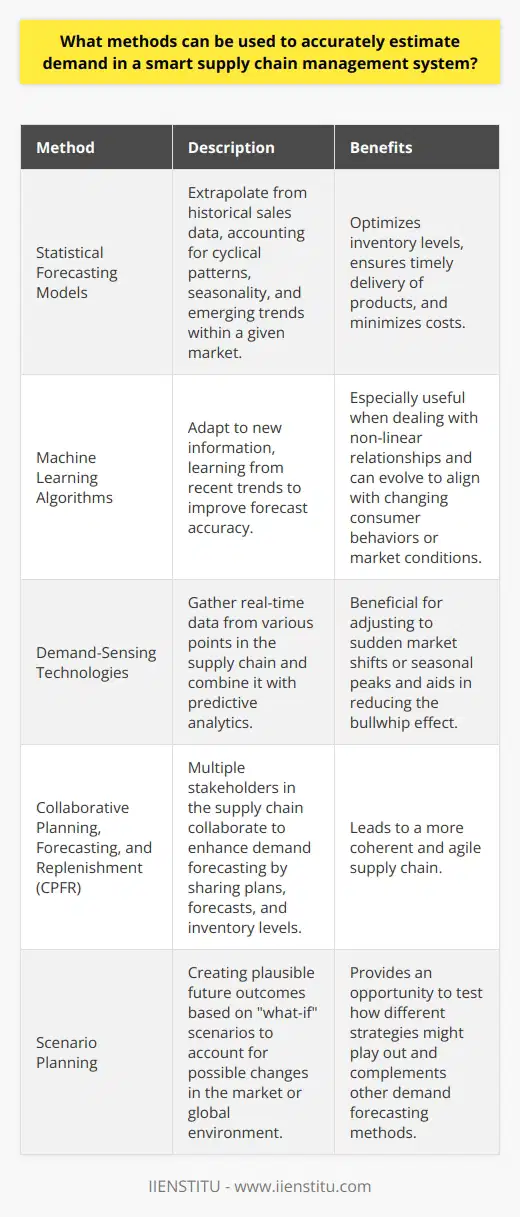
How can understanding customer needs help with demand forecasting?
Demand forecasting is essential to managing a successful business, as it allows companies to anticipate customer demand and plan for future success. To accurately forecast customer demand, it is crucial to have a thorough understanding of customer needs.
The first step to understanding customer needs is to gain insight into customer preferences. This can be accomplished through market research, customer surveys, and customer feedback. Market research provides a comprehensive view of customer preferences, while surveys and feedback provide more targeted insights. With this information, companies can better understand the customer’s needs and desires and use this data to anticipate future demand.
Another critical factor in understanding customer needs is clearly understanding the customer’s buying cycle. Companies should know when customers typically purchase products and services and what factors influence their purchasing decisions. Companies can anticipate customer demand and plan accordingly by understanding the customer's buying cycle.
Finally, companies should also be aware of changes in customer needs over time. Customer preferences and buying cycles can change over time, and companies need to be able to anticipate these changes to forecast customer demand effectively. Companies should keep up to date with industry trends, customer feedback, and market research to stay abreast of changes in customer needs.
In conclusion, understanding customer needs is essential for successful demand forecasting. Companies should utilize market research, customer surveys, and customer feedback to gain insight into customer preferences and buying cycles. Additionally, companies should stay updated with industry trends and customer feedback to anticipate changes in customer needs. With a thorough understanding of customer needs, companies can effectively forecast customer demand and plan for future success.
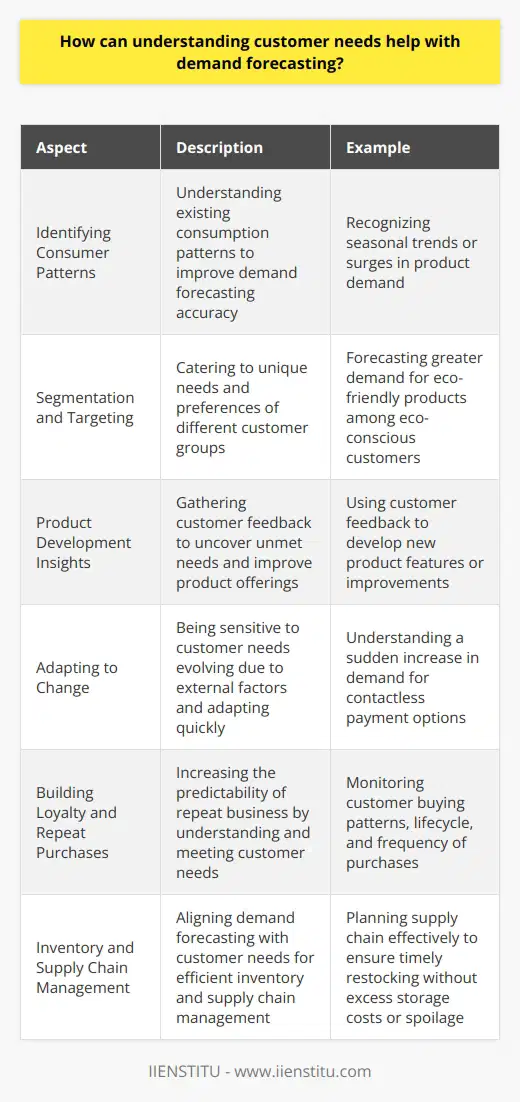
What factors should be taken into consideration when choosing suppliers for a smart supply chain management system?
To successfully implement an intelligent supply chain management system, it is essential to consider several factors when selecting suppliers. This article will discuss critical factors that should be considered when choosing suppliers for an intelligent supply chain management system.
The first factor to consider is supplier reputation. When choosing a supplier, it is essential to ensure that they have a good reputation in the industry, as this will indicate their reliability and trustworthiness. Additionally, it is advisable to research customer feedback and reviews to gain further insight into the supplier’s capabilities and service levels.
The second factor is the supplier’s ability to provide the necessary technology and capabilities. An intelligent supply chain management system requires sophisticated software and hardware to handle large data volumes. Therefore, it is essential to ensure that the supplier can provide the necessary technology and capabilities to meet your needs.
The third factor is the supplier’s ability to provide the necessary support. An intelligent supply chain management system requires ongoing maintenance and helps to ensure that it is running smoothly. Therefore, it is essential to ensure that the supplier can provide the necessary support and resources to ensure your system runs optimally.
The fourth factor to consider is cost. It is essential to ensure that the cost of the supplier’s products and services is reasonable and within budget. Additionally, comparing prices from different suppliers is beneficial to ensure that you are getting the best value for your money.
The fifth factor to consider is the supplier’s ability to offer scalability. It is likely that your business needs will change over time. Therefore, it is essential to ensure that the supplier can provide scalability, allowing you to increase or decrease the number of services and products purchased.
Finally, it is essential to consider the supplier’s commitment to innovation. As technology advances, it is necessary to ensure that the supplier is committed to keeping up with the latest developments and innovations to ensure that your system remains up-to-date and efficient.
In conclusion, several factors should be considered when selecting suppliers for an intelligent supply chain management system. These include supplier reputation, technology and capabilities, cost, scalability, and commitment to innovation. By considering these factors, businesses can ensure that they select the right supplier for their intelligent supply chain management system and ensure a successful implementation.
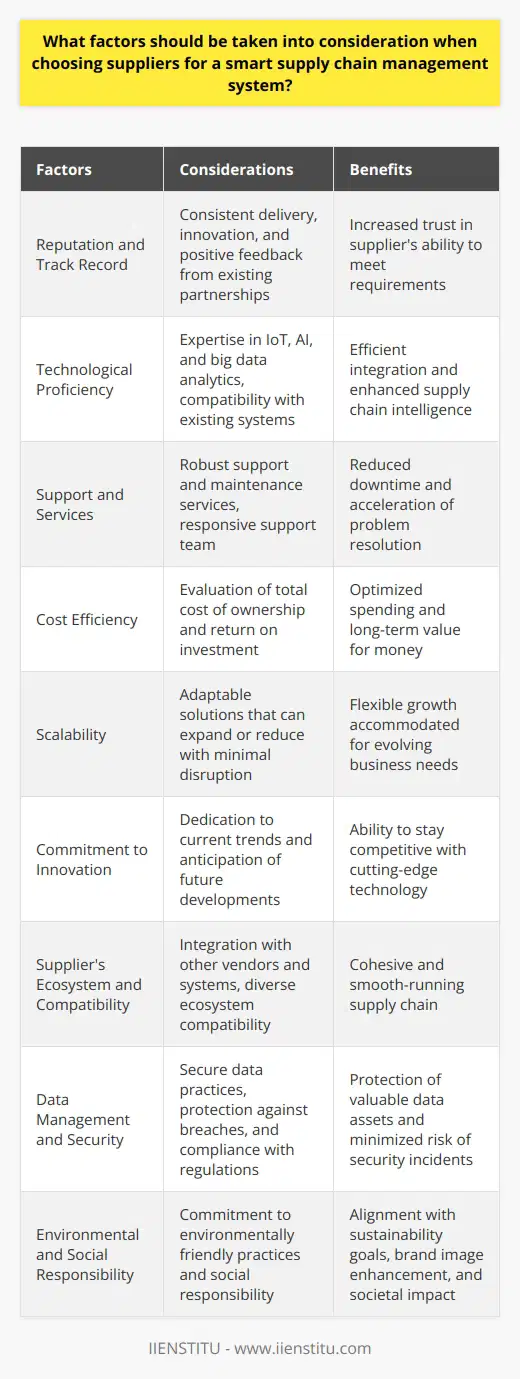
How do you incorporate demand planning processes in the overall supply chain management strategy?
Understanding Demand Planning
To incorporate demand planning processes in the overall supply chain management strategy, it is crucial to first understand its significance. Demand planning refers to the practice of predicting future customer demand, enabling organizations to balance inventory levels, production output and procurement efforts effectively. This entails combining historical sales data, market analysis, and expert input to generate accurate forecasts for future demand patterns.
Collecting and Analyzing Data
The initial step in incorporating demand planning is the collection and analysis of relevant data. Through various methods such as examining historical sales data, tracking market trends and customer feedback, firms can develop an in-depth understanding of their product demand. This analysis further aids in identifying seasonal patterns, enabling the business to respond proactively to fluctuations in demand. By continuously updating and refining the demand forecast, they can gain an accurate picture of potential customer needs and reduce the risk of over- or under-stocking products.
Collaborative Efforts
A vital component of successful demand planning processes is collaboration – both internal and external. Internal collaboration refers to communication between departments within the organization, such as sales, marketing, and production teams. These teams need to work together closely to share information and insights, ensuring a comprehensive view of demand. External collaboration involves coordination with suppliers and distributors, which helps in making well-informed decisions about inventory and production planning. By fostering a collaborative environment, businesses can improve their overall supply chain efficiency, increasing profitability and improving customer satisfaction.
Demand Driven Supply Chain
Incorporating demand planning effectively transforms supply chain management into a demand-driven supply chain, where production and inventory decisions are based on accurate demand forecasts. Demand-driven supply chains rely on accurate and timely demand signals, ensuring that the appropriate products are in stock and accessible to customers. This approach reduces inventory costs, increases responsiveness to market changes, and ultimately enhances the end-to-end performance of the supply chain.
Continuous Improvement
Finally, the process of demand planning and integration into supply chain management requires continuous improvement. Companies must continually monitor their demand planning processes, identifying areas of inefficiency and opportunities for advancement. By refining forecasting models, incorporating new data sources, and maintaining strong communication channels throughout the supply chain, organizations can effectively adapt to changes in customer preferences and market conditions.
In conclusion, integrating demand planning into supply chain management strategy involves understanding its importance, collecting and analyzing data, fostering collaboration, transitioning to a demand-driven supply chain, and implementing continuous improvements. By following these steps, businesses can optimize their supply chain performance and enhance overall efficiency.
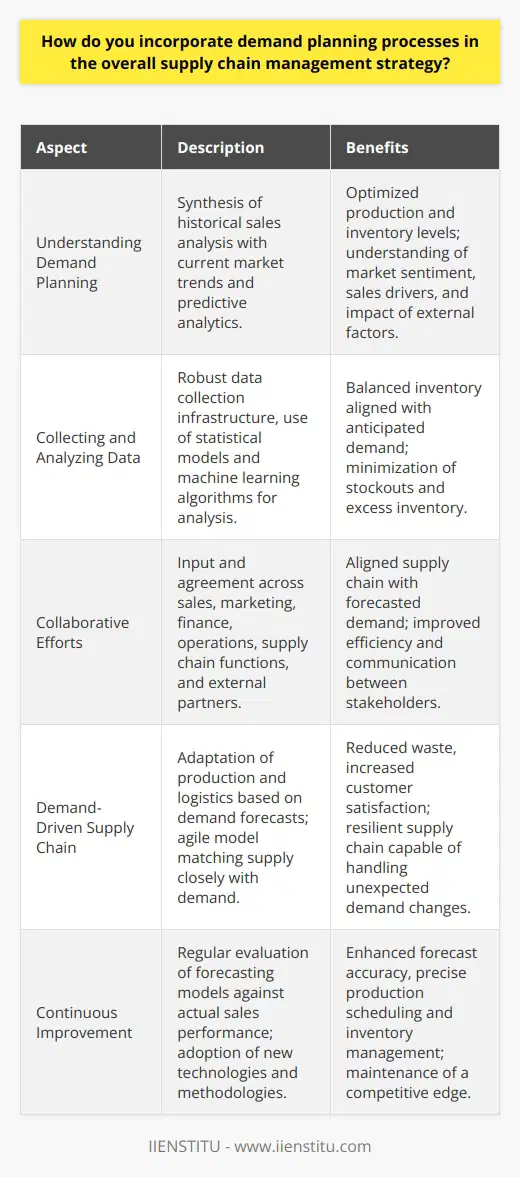
What are the key components of a successful smart supply chain management system?
Subheadings: Integration and Collaboration, Real-Time Data Analysis, Flexibility and Adaptability, Enhanced Automation, and Sustainable Practices
Integration and Collaboration
A successful smart supply chain management system requires strong integration and collaboration among stakeholders, including suppliers, manufacturers, distributors, and customers. Such cooperation promotes efficiency, information sharing, and aligned goals, ultimately improving the overall performance.
Real-Time Data Analysis
Another essential component is real-time data analysis, which utilizes advanced technologies such as Internet of Things (IoT) sensors and artificial intelligence (AI). These tools enable decision-makers to continuously monitor and assess supply chain operations, identify potential problems, and make informed decisions, optimizing operations and minimizing risks.
Flexibility and Adaptability
Flexibility and adaptability are key to navigating fluctuations in demand, supply, or other external factors. A smart supply chain management system should be able to adjust and respond to changing conditions, such as disruptions or new market opportunities, maintaining high levels of efficiency and competitiveness.
Enhanced Automation
Technological advancements in automation, robotics, and AI play a significant role in modernizing and improving supply chain operations. Incorporating these tools into a smart supply chain management system enables organizations to streamline and optimize processes, reduce human error, and increase overall efficiency and accuracy.
Sustainable Practices
Lastly, a successful smart supply chain management system must prioritize sustainability, considering factors like reducing waste, conserving resources, and minimizing negative environmental impacts. By integrating sustainable practices, organizations not only achieve a more efficient and effective supply chain, but they also demonstrate their commitment to corporate social responsibility, promoting a positive brand image.
In summary, a well-designed smart supply chain management system incorporates integration and collaboration, real-time data analysis, flexibility and adaptability, enhanced automation, and sustainable practices. By addressing these key components, organizations can successfully optimize their supply chains, increase efficiency, and maintain a competitive advantage in today's rapidly evolving global market.
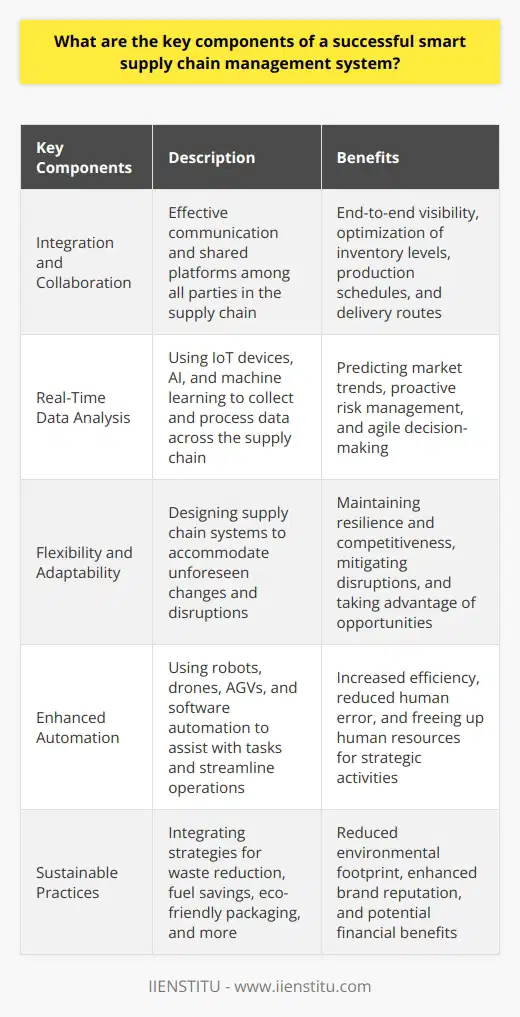
How is technology utilized in managing and estimating supply chain demand effectively?
Utilizing Technology in Demand Forecasting
One of the major ways technology is utilized in managing and estimating supply chain demand is through demand forecasting. This process involves the use of historical sales data and statistical models to predict the future demand for a product or service. With advancements in technology, this process has become increasingly accurate and efficient, allowing businesses to better strategize and allocate resources to meet customer needs.
Incorporating Data Analytics
Data analytics plays a critical role in predicting future demand accurately. Data-driven insights can assist managers in identifying trends and fluctuations in the market. As they analyze large quantities of historical data, businesses can identify seasonal patterns, regional preferences, and even product preferences of their customers. By leveraging the power of data analytics, it becomes easier to anticipate future customer needs and tailor their supply chain accordingly.
Real-Time Tracking of Inventory Levels
Another way technology assists in estimating supply chain demand effectively is through real-time inventory tracking systems. These systems help companies monitor their stock levels, identify potential shortages, and ensure that they have sufficient inventory to meet their customers' needs. By using real-time data, businesses can quickly respond to changes in demand and reduce the risk of stockouts or excess inventory.
Integrating Artificial Intelligence
The integration of artificial intelligence (AI) and machine learning into demand planning and supply chain management is a game-changer. AI algorithms can analyze vast amounts of data, including historical sales trends, market factors, and customer feedback, to provide highly accurate demand forecasts. Machine learning capabilities allow the AI system to continuously refine its predictions as more data is collected. This facilitates a more proactive management approach, resulting in improved efficiency and effectiveness of the supply chain.
Virtual Reality and Simulation
Virtual reality (VR) and computer simulations are also increasingly being employed to optimize supply chain planning and demand estimation. These digital tools enable supply chain managers to visualize different scenarios based on various factors such as production capacity, warehouse space, and transportation resources. By simulating how different events could impact the supply chain, managers can develop contingency plans and explore alternative strategies, leading to enhanced resilience and responsiveness in the face of uncertainties.
In conclusion, technology plays a vital role in managing and estimating supply chain demand effectively. This includes leveraging data analytics, real-time inventory tracking, artificial intelligence, and virtual reality to facilitate better decision-making, improved resource allocation, and more accurate demand forecasting. As technology continues to evolve, businesses that embrace and capitalize on these advancements will be better equipped to navigate the complexities of supply chain management and meet the growing demands of their customers.
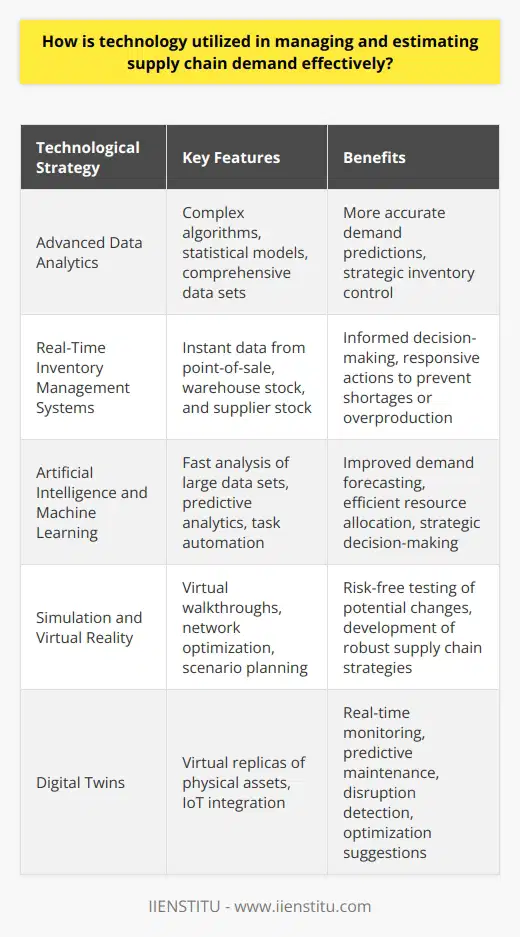
How do demand management techniques influence the efficiency of supply chain operations?
Demand Management and Supply Chain Operations
Demand management plays a pivotal role in maximizing the efficiency of supply chain operations. When executed effectively, this technique can significantly streamline logistical processes and optimize resource allocation.
Understanding Demand-Supply Dynamics
Supply chains must routinely grapple with demand and supply fluctuations. Accurate demand forecasting is indispensable in aligning supply chain operations with market trends. Notably, it minimizes stock redundancies and shortages, resulting in cost-efficiency.
Inventory Management
Effective demand management directly influences inventory management. Balanced inventory levels prevent overstocking or understocking, contributing to overall operational efficiency. Such balance allows firms to respond on time to sudden market demand surges, sustaining customer satisfaction and loyalty.
Lead Time Reduction
Demand management also aids in reducing lead times. When forecasted demand aligns accurately with production, the time lag between order placement and delivery decreases. Shorter lead times enhance customer satisfaction, boost sales, and improve profitability.
Supplier Relationships
Robust demand management can strengthen supplier relationships. Predictable demand mitigates stress on suppliers by allowing them adequate preparation time. This stability nurtures long-term, mutually beneficial partnerships that are crucial for efficient supply chain operations.
Conclusion
In essence, demand management influences the efficiency of supply chain operations through improved inventory management, decreased lead times, and strengthened supplier relationships. Therefore, its strategic importance in supply chain efficiency cannot be overstated.
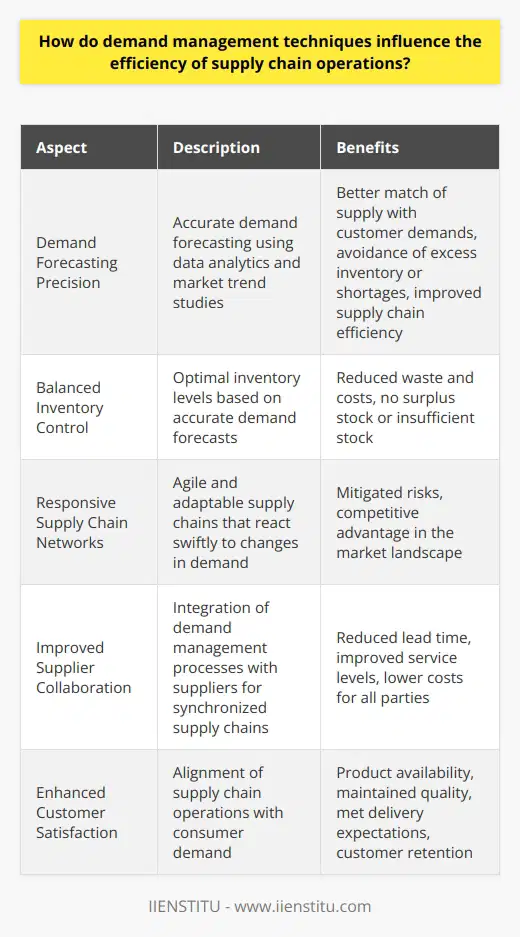
What are the benefits and potential risks associated with implementing smart supply chain management practices?
Benefits of Smart Supply Chain Management
Smart supply chain management practices can greatly enhance operational efficiency. These practices can provide real-time visibility into logistics and supply chain operations. Advanced technologies, including artificial intelligence and automation, can manage inventories more effectively. Consequently, such practices can reduce costs through improved resource allocation and better demand forecasting.
Additionally, smart supply chains can enhance supplier relationships. Digital platforms can streamline communication and facilitate collaboration. This results in improved delivery times and product quality, leading to increased customer satisfaction. Besides, smart supply chains aid sustainable practices, which are increasingly demanded by consumers and stakeholders.
Risks Involved in Implementing Smart Supply Chain Management
Despite the benefits, potential risks can arise. Cybersecurity threats pose significant risks, as smart supply chains rely heavily on digital solutions. Therefore, any data breach or cyber-attack can disrupt operations severely.
The transition towards smart supply chain practices can also be challenging. It requires substantial investment in technology and human resources. Also, staff may resist change, making it critical to manage human factors during transition.
Furthermore, reliance on technology can lead to overdependence, potentially reducing flexibility and adaptability. Navigating through periods of interrupted connectivity or technology failures can prove problematic. Additionally, smart supply chains may magnify inherent risks in the supply chain, such as supplier failure or market fluctuations.
In conclusion, while smart supply chain management can bring about enhanced efficiencies and improved relationships, it is not without potential risks. Businesses must carefully consider and mitigate these challenges when transitioning to smarter practices. Proper planning, robust network infrastructure, strong cybersecurity measures, and comprehensive change management strategies can go a long way in ensuring the successful delivery of smart supply chain management benefits.
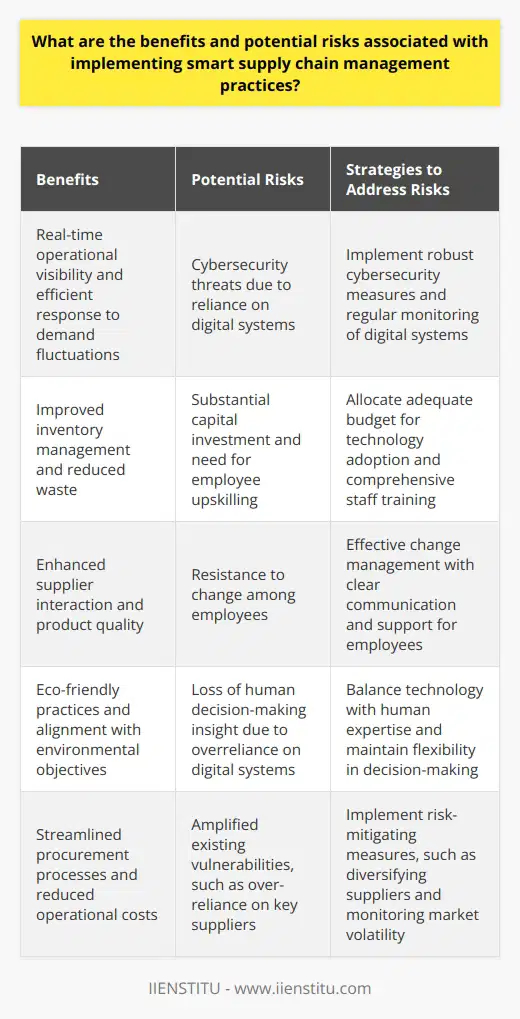
How can demand forecasting strategies be incorporated into various stages of the supply chain planning process?
Initial Planning Stage
In the initial planning phase, demand forecasting is key to determine suitable inventory levels. Deep study of market trends and consumer behaviors can guide these predictions. Accurate forecast aids to avoid under or overstocking.
Development Strategy Stage
In the development strategy stage, demand forecasting helps to design effective supply chain strategy. Comprehensive forecasting involves consideration of various factors such as market volatility, seasonal demands, and product lifecycle. This process allows firms to develop robust supply chain strategies that align with market demands.
Production Planning Stage
Fine tuning of the production plan requires demand forecasting too. Accurate forecasts provide better clarity on how much to produce and when. This approach reduces the likelihood of wastage due to overproduction and minimizes the chances of stockouts.
Inventory Control Stage
Demand forecasting plays a pivotal role in the inventory control stage. It assists in defining the optimal reorder level, order quantity and safety stock. It helps to smoothly balance the demand-supply equation, thereby optimizing inventory costs.
Transportation and Distribution Strategy
In the transportation and distribution stage, forecast of demand is incorporated to plan efficient logistics. Predicting which products to transport and in what volume helps limit unnecessary costs and ensures timely delivery.
Customer Satisfaction Stage
Finally, at the customer satisfaction stage, anticipating future demand guarantees that customers will find the goods they need, when they need them. This enhances customer satisfaction and loyalty, a valuable asset for any business.
In conclusion, incorporating demand forecasting strategies into every stage of the supply chain planning process can significantly improve operations, leading to cost effectiveness, enhanced customer satisfaction, and overall business success.
